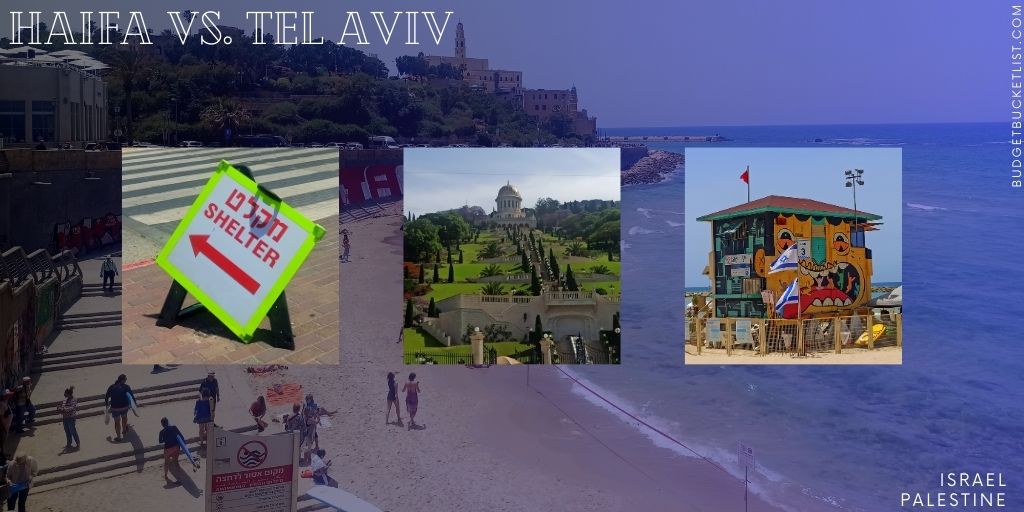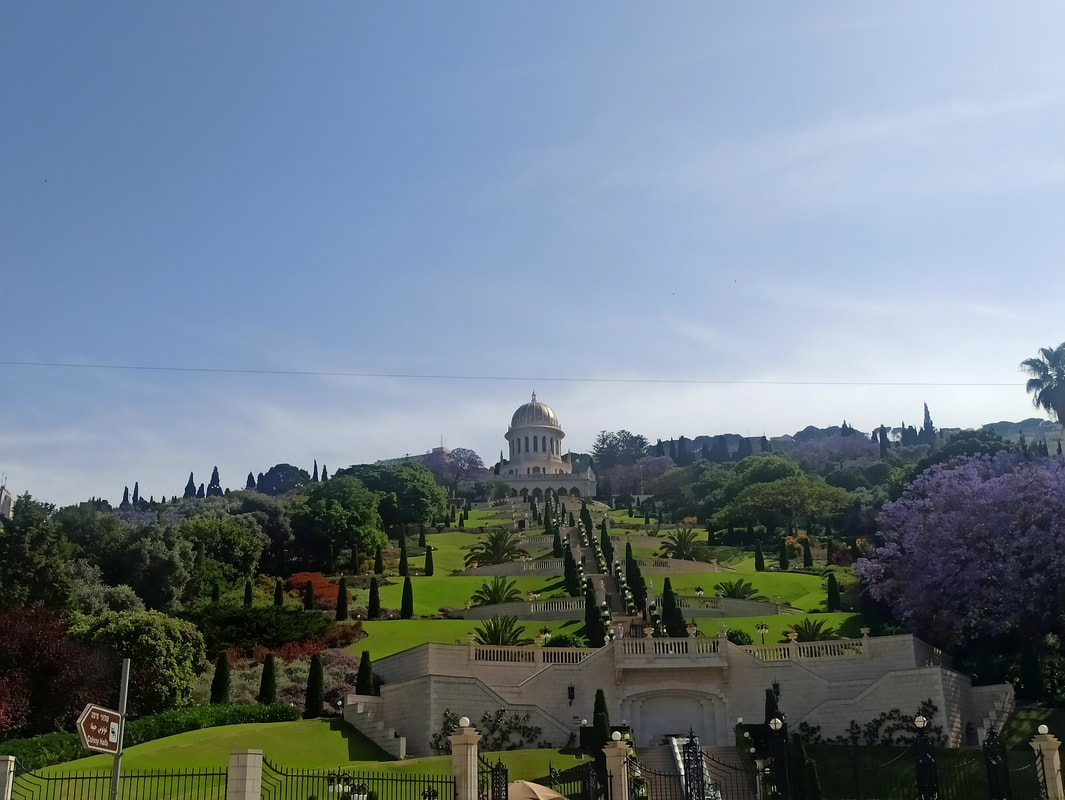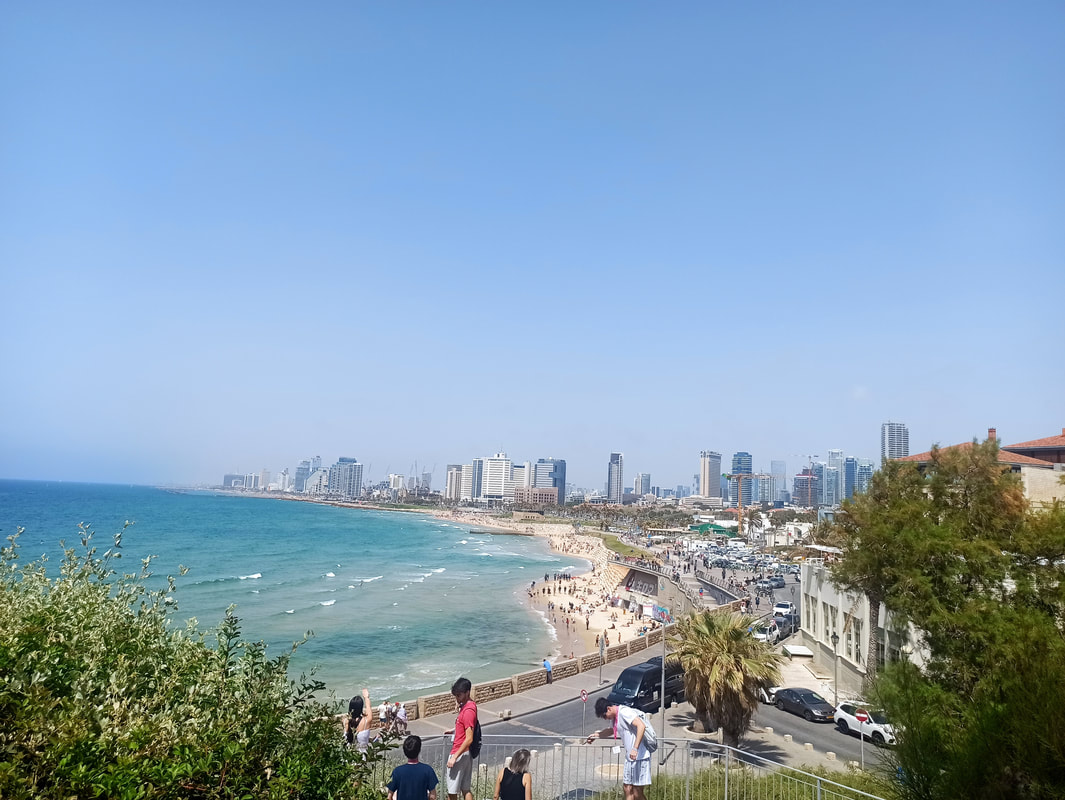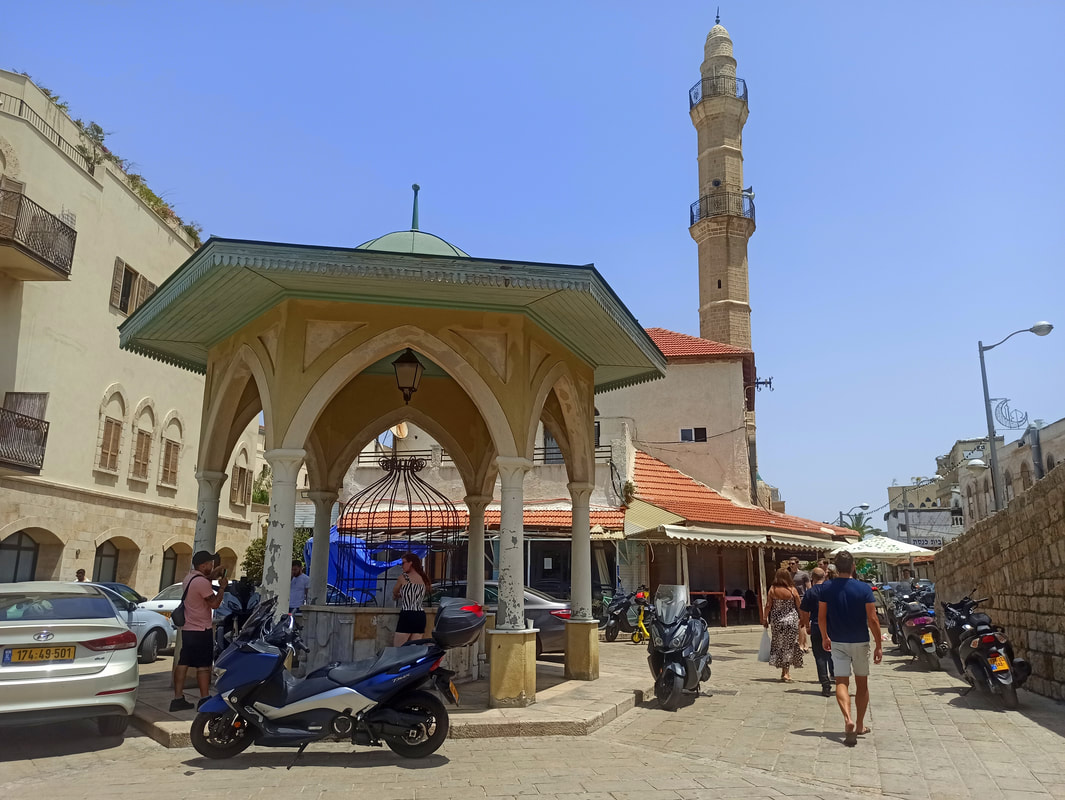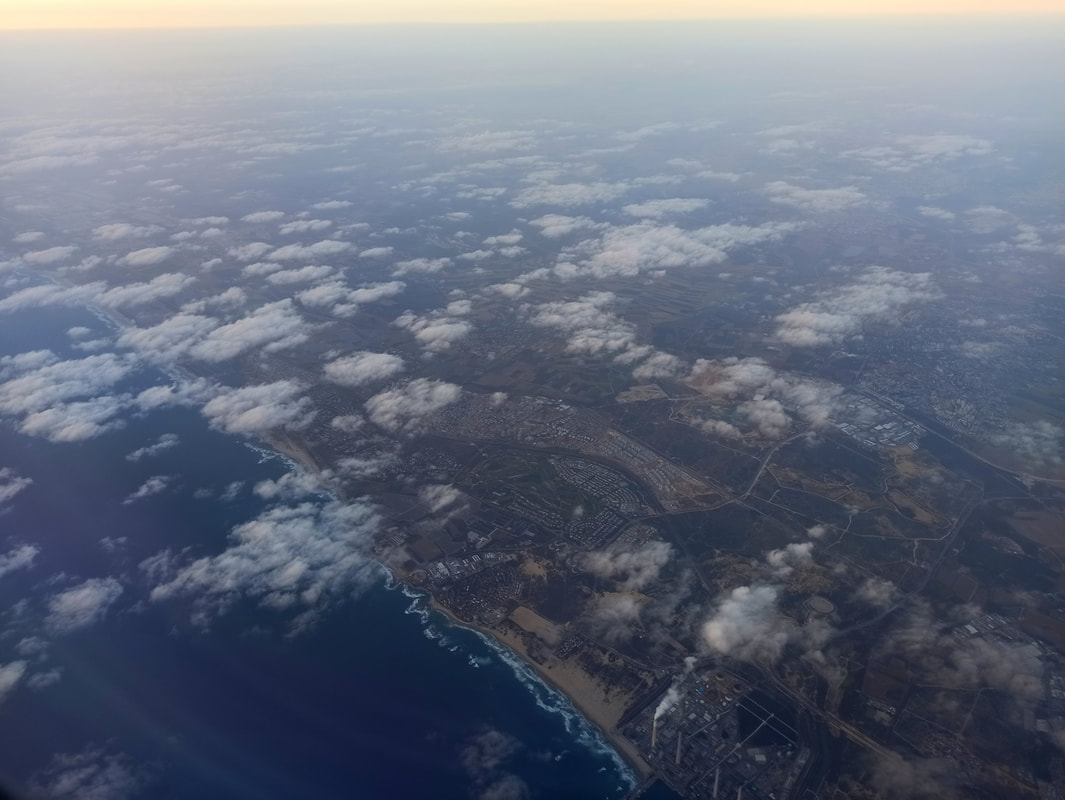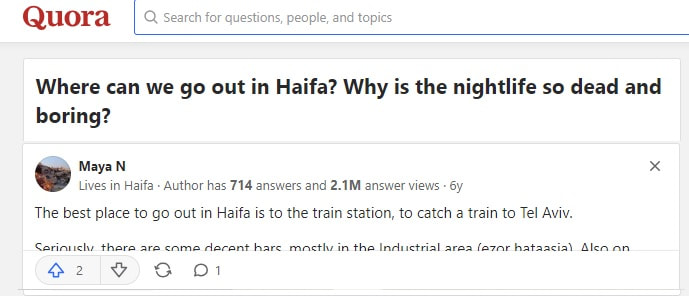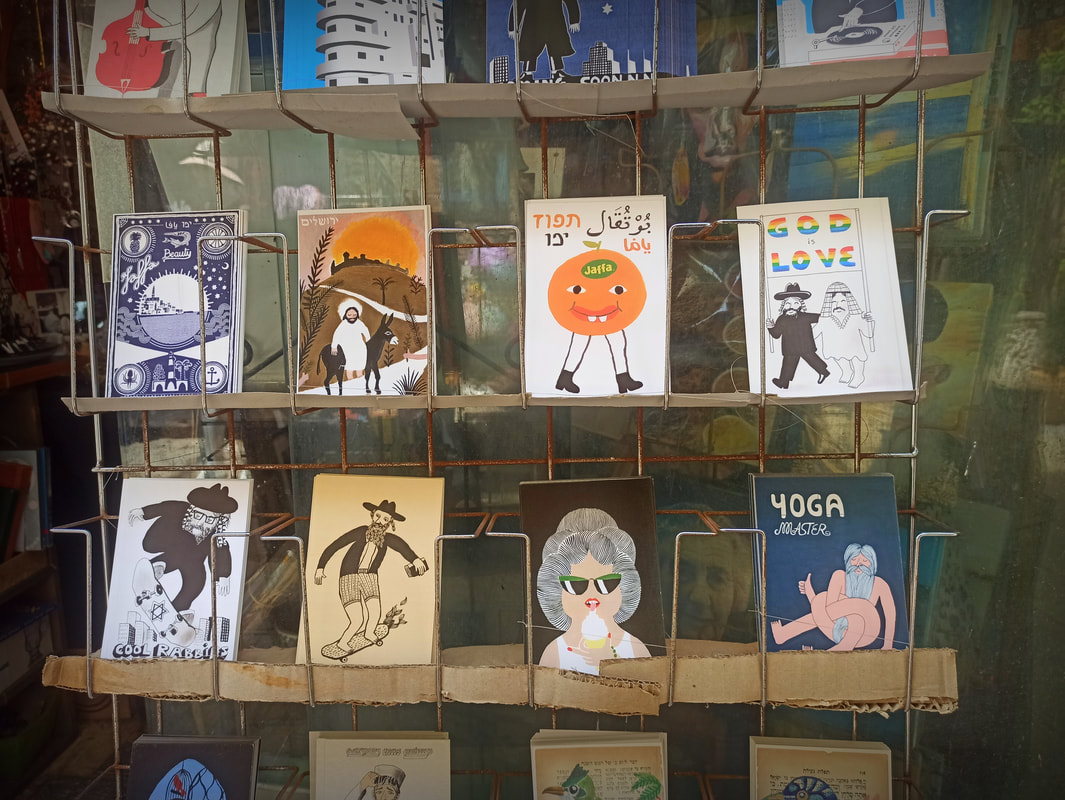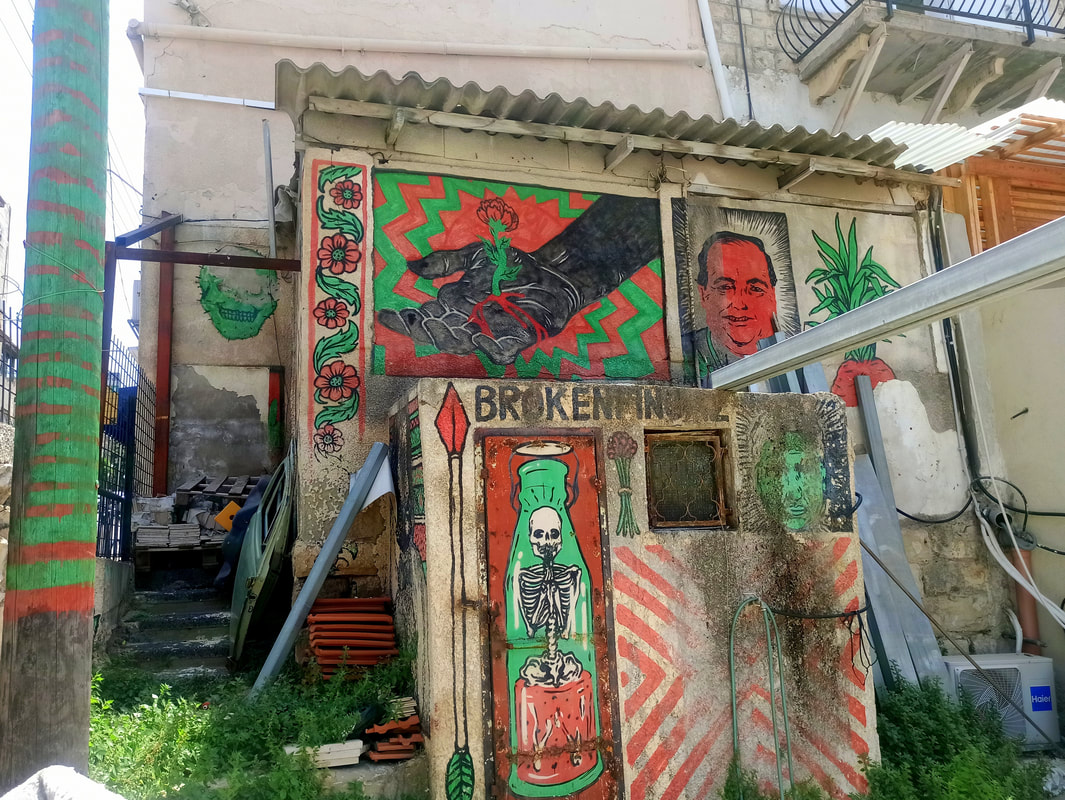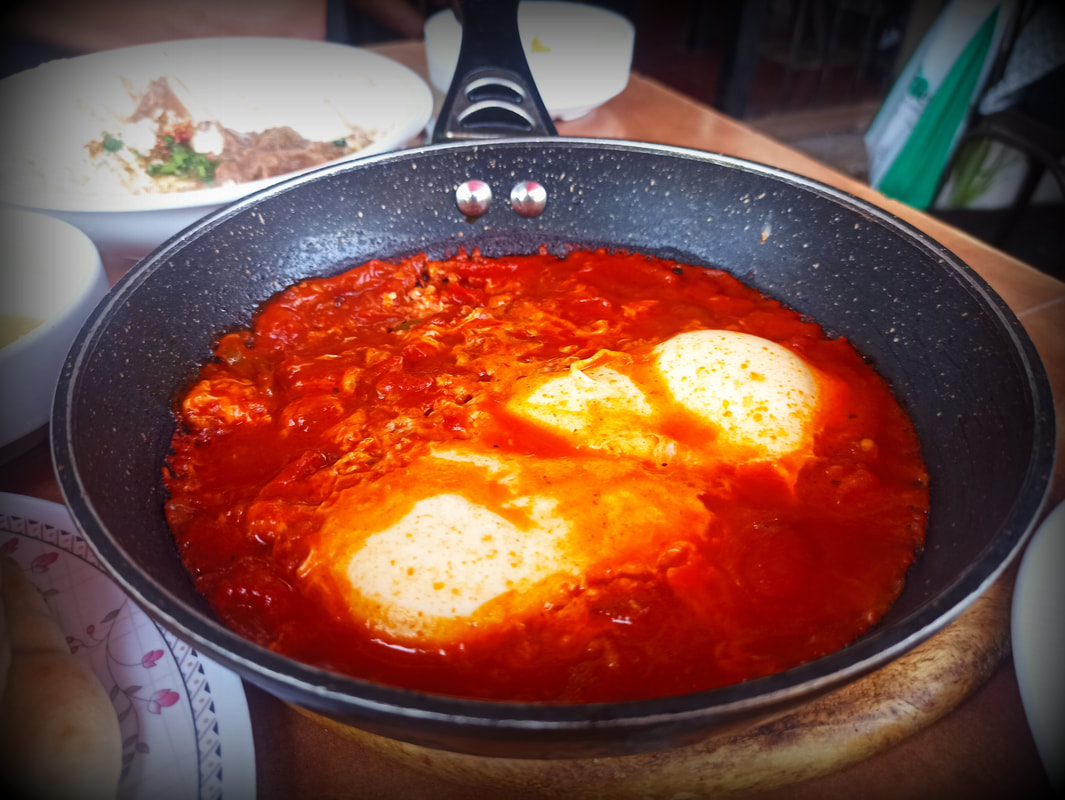Haifa vs. Tel Aviv
Not in the story-mood? Scroll down for the Quick Budget Fact Overview: an itemized information summary of Haifa & Tel Aviv! ↓
Both are gracefully located on the coastline, embracing the Mediterranean with luminous beach strips. Both contain UNESCO World Heritage Sites as well as attractions of literally biblical stature. Both are home to talented painters and architects who left their unique mark on the cities, and both host a remarkable collection of internationally renowned museums. One has rich natural wealth, the other a bustling nightlife. I’m of course talking about Palestine’s/Israel’s second and third biggest cities*, Tel Aviv and Haifa.
Similar in many ways, but each also accentuating their distinctive personalities… the big question is, which one wins? In the battle of the giants, who rises above the other and blinds the opponent with its superior brilliance?
* The biggest city is Jerusalem, which is of course a category on its own.
Similar in many ways, but each also accentuating their distinctive personalities… the big question is, which one wins? In the battle of the giants, who rises above the other and blinds the opponent with its superior brilliance?
* The biggest city is Jerusalem, which is of course a category on its own.
Too busy to read now? No problem, save it for later!
Save on Get Pocket | Save in Browser Bookmarks| Save on Instapaper
Save on Get Pocket | Save in Browser Bookmarks| Save on Instapaper
Let the battle begin:
Round 1: Beach
Haifa
Even though Haifa is a coastal destination, you don’t necessarily notice that when strolling the city centre. Sure, it’s hard to ignore the commercial harbour in the background… but as Haifa is the country’s biggest port city, this is more of an industrial nature. In my opinion Haifa doesn’t breathe those marine, sea salt vibes of your standard, ordinary beach town. That doesn’t mean there aren’t any beaches to be enjoyed though. If you’re down for an hourly hike out of the city centre, you can grant yourself a visit to popular stops such as the Carmel, Dado, Student and Gilad Beach (all the same strip). Closer to the central train station, you’ll have the option to go for a plunge at the tiny Bat Galim Beach, which is popular among surfers, or at the so-called Quiet Beach overlooking the industrial port area.
Tel Aviv
Quite the contrary is Tel Aviv, whose shoreline forms the main attraction in town. Sure, the second-largest city of Palestine/Israel offers a wide variety of neighbourhoods and areas, all unique in its own ambience and catering to a wide variety of crowds… yet, this metropolitan destination seems to concentrate on the lengthy and lively coastline, sprouting out of Jaffa, which is one of the most ancient ports in the world. Sounds familiar? Correct, it received some free PR in the Bible. If you want to go just beyond a lazy beach day, consider grabbing the opportunity to walk the 4km Tayelet Boardwalk, continuing all the way to the Charles Clore Park. Or join the locals in their play of beach volley or ‘matkot’: a typical Israelian padel game played with a rubber ball and wooden racket. It made its entry in the 1920s and is so immensely popular that it’s locally considered as the ‘national beach sport.’ Besides that, Tel Aviv is considered to be the Surf Capital of the country, hosting the most well-known surf spot: Hilton Beach. Keep in mind that although there’s a long list of beach names in Tel Aviv, most downtown ones refer to a certain area of the exact same uninterrupted strip… a strip that is, undeniably, a downright glorious stretch of shoreline. The lifeline of Tel Aviv.
Winner: Tel Aviv
Round 1: Beach
Haifa
Even though Haifa is a coastal destination, you don’t necessarily notice that when strolling the city centre. Sure, it’s hard to ignore the commercial harbour in the background… but as Haifa is the country’s biggest port city, this is more of an industrial nature. In my opinion Haifa doesn’t breathe those marine, sea salt vibes of your standard, ordinary beach town. That doesn’t mean there aren’t any beaches to be enjoyed though. If you’re down for an hourly hike out of the city centre, you can grant yourself a visit to popular stops such as the Carmel, Dado, Student and Gilad Beach (all the same strip). Closer to the central train station, you’ll have the option to go for a plunge at the tiny Bat Galim Beach, which is popular among surfers, or at the so-called Quiet Beach overlooking the industrial port area.
Tel Aviv
Quite the contrary is Tel Aviv, whose shoreline forms the main attraction in town. Sure, the second-largest city of Palestine/Israel offers a wide variety of neighbourhoods and areas, all unique in its own ambience and catering to a wide variety of crowds… yet, this metropolitan destination seems to concentrate on the lengthy and lively coastline, sprouting out of Jaffa, which is one of the most ancient ports in the world. Sounds familiar? Correct, it received some free PR in the Bible. If you want to go just beyond a lazy beach day, consider grabbing the opportunity to walk the 4km Tayelet Boardwalk, continuing all the way to the Charles Clore Park. Or join the locals in their play of beach volley or ‘matkot’: a typical Israelian padel game played with a rubber ball and wooden racket. It made its entry in the 1920s and is so immensely popular that it’s locally considered as the ‘national beach sport.’ Besides that, Tel Aviv is considered to be the Surf Capital of the country, hosting the most well-known surf spot: Hilton Beach. Keep in mind that although there’s a long list of beach names in Tel Aviv, most downtown ones refer to a certain area of the exact same uninterrupted strip… a strip that is, undeniably, a downright glorious stretch of shoreline. The lifeline of Tel Aviv.
Winner: Tel Aviv
Round 2: Culture
Haifa
In order to grasp something as complex as ‘the culture of a city’, it is necessary to dive into the history of the area… which by all means, complicates the matter even more. As in a place like Israel/Palestine, there’s no such a thing as ‘one culture.’ This forms both a blessing and the root of all problems this geographical area is currently facing. As Haifa’s poorly done City Museum helps very little in shedding light on the matter (they’re more focused on the life of Mike Brant, a singer neither you nor I have ever heard of), I will give it a go myself. Haifa is a city that changed hands and demographics more than one can easily count*, forming the rather confusing yet varied cultural offer we can explore today.
* Over the millennia the area of Haifa has been ruled by the Caanites, Israelites, Phoenicians, Assyrians (Syria), Babylonians, Persians, Hasmoneans, Romans, Byzantines, Arabs, Crusaders, Ottomans, British… until it formed part of the contested State of Israel.
For one, the city is scenically built on the slopes of the biblical Mount Carmel, housing the grotto known as the ‘Cave of Elijah’ which formed a place of pilgrimage in the past and continues to do so in the present. Even though the area (its initial settlement known as Tell Abu Hawam in the 14th century BC) didn’t take on any significant role other than just a simple fishermen village, the religious meaning behind Mount Carmel caused a burst in growth in the 12th century, when catholic hermits started inhabiting the caves on the Carmel. Hence: The Carmelites, a new monastic order. The church they built over Prophet Elijah’s assumed cave forms one of the main attractions today: the Stella Maris Monastery.
Fast-forward to the Ottoman Empire, which conquered Palestine in 1516. Even though it had declined in wealth and population by that time, the boom in trade the Ottomans brought along powered Haifa’s revival as a flourishing port town. This era laid the foundations of the Haifa we can experience today. Especially mid-18th century, Haifa slowly became overcrowded and literally burst out of its seems, forcing city expansion on the mountain slope. Besides the Muslims (predominant), Jews and Christians, the German Messianics (of which many Templars) settled in, establishing what is currently still known as the German Colony. Another influence, forever changing the face of Haifa, came from the Baha’i faith. When the remains of the Bab, the founder, were moved from Acre to Haifa to be placed in a golden-domed shrine on Mount Carmel, the city gained its prime attraction. The Baha’i Shrine itself is regarded as their second holiest place on Earth, whereas the Baha’i Gardens surrounding the sight are UNESCO World Heritage. Another UNESCO site can be found at only half an hour of traveling: the Old City of Acre.
* By train or with bus 798.
Under the influence of the British Mandate, forced upon the locals in 1918, Haifa’s status of an industrial heavyweight temporarily overshadowed the development of outstanding cultural attractions, besides the increasing influx of migrants aiding the city’s multi-faith and multinational character… a character that subsequently thinned down again to a dominant Jewish community, once an external party decided to award them this state. From this moment on new cultural sights were added to Haifa’s cityscape, such as Madatech, the national museum of science, technology and space, and the Haifa Museum of Art, exhibiting a very powerful collection of Haifa- and northern-based artists reflecting topics of social class, immigration and life’s duality. Art aficionados can make a full daytrip out of it by adding the Chagall Artist House (the artist shortly lived here) and the Ein Hof Artists Village to their visit.
Haifa
In order to grasp something as complex as ‘the culture of a city’, it is necessary to dive into the history of the area… which by all means, complicates the matter even more. As in a place like Israel/Palestine, there’s no such a thing as ‘one culture.’ This forms both a blessing and the root of all problems this geographical area is currently facing. As Haifa’s poorly done City Museum helps very little in shedding light on the matter (they’re more focused on the life of Mike Brant, a singer neither you nor I have ever heard of), I will give it a go myself. Haifa is a city that changed hands and demographics more than one can easily count*, forming the rather confusing yet varied cultural offer we can explore today.
* Over the millennia the area of Haifa has been ruled by the Caanites, Israelites, Phoenicians, Assyrians (Syria), Babylonians, Persians, Hasmoneans, Romans, Byzantines, Arabs, Crusaders, Ottomans, British… until it formed part of the contested State of Israel.
For one, the city is scenically built on the slopes of the biblical Mount Carmel, housing the grotto known as the ‘Cave of Elijah’ which formed a place of pilgrimage in the past and continues to do so in the present. Even though the area (its initial settlement known as Tell Abu Hawam in the 14th century BC) didn’t take on any significant role other than just a simple fishermen village, the religious meaning behind Mount Carmel caused a burst in growth in the 12th century, when catholic hermits started inhabiting the caves on the Carmel. Hence: The Carmelites, a new monastic order. The church they built over Prophet Elijah’s assumed cave forms one of the main attractions today: the Stella Maris Monastery.
Fast-forward to the Ottoman Empire, which conquered Palestine in 1516. Even though it had declined in wealth and population by that time, the boom in trade the Ottomans brought along powered Haifa’s revival as a flourishing port town. This era laid the foundations of the Haifa we can experience today. Especially mid-18th century, Haifa slowly became overcrowded and literally burst out of its seems, forcing city expansion on the mountain slope. Besides the Muslims (predominant), Jews and Christians, the German Messianics (of which many Templars) settled in, establishing what is currently still known as the German Colony. Another influence, forever changing the face of Haifa, came from the Baha’i faith. When the remains of the Bab, the founder, were moved from Acre to Haifa to be placed in a golden-domed shrine on Mount Carmel, the city gained its prime attraction. The Baha’i Shrine itself is regarded as their second holiest place on Earth, whereas the Baha’i Gardens surrounding the sight are UNESCO World Heritage. Another UNESCO site can be found at only half an hour of traveling: the Old City of Acre.
* By train or with bus 798.
Under the influence of the British Mandate, forced upon the locals in 1918, Haifa’s status of an industrial heavyweight temporarily overshadowed the development of outstanding cultural attractions, besides the increasing influx of migrants aiding the city’s multi-faith and multinational character… a character that subsequently thinned down again to a dominant Jewish community, once an external party decided to award them this state. From this moment on new cultural sights were added to Haifa’s cityscape, such as Madatech, the national museum of science, technology and space, and the Haifa Museum of Art, exhibiting a very powerful collection of Haifa- and northern-based artists reflecting topics of social class, immigration and life’s duality. Art aficionados can make a full daytrip out of it by adding the Chagall Artist House (the artist shortly lived here) and the Ein Hof Artists Village to their visit.
Tel Aviv
As Tel Aviv isn’t too far away from Haifa, this area knows a similar occupation history. However, there was no such a thing as Tel Aviv back then, the history centres all around Jaffa. Archaeological evidence suggest the first signs of human settlement in this area as early as 7500BC, whereas the city of Jaffa was established around 1800BC… just like Haifa, also developing as a crucial harbour hub. During the Ottoman rule, specifically when Jewish immigrants started to arrive around the 1880s, new neighbourhoods emerged outside of the (Arabic) Jaffa area, laying the foundations for what is now Tel Aviv. A city which, by the way, didn’t just gradually and organically come into existence, but which was carefully planned and designed to be a modern independent Hebrew housing estate with wide boulevards, street lights, electricity and running water. Tel Aviv was founded in 1909 and became independent from Jaffa in 1934.
In the uprise of Tel Aviv, cultural institutions such as the Ben Gurion House, the Ohel Theatre and the Habima Theatre were established. After the Nazis came to power, the immigration stream of Jews towards their hubs understandably strengthened, which included many German Jewish architects from the Bauhaus discipline. This movement forms the basis of the emergence of the so-called White City: with over 4000 buildings in the Bauhaus style the largest collection worldwide. Nowadays, this area is recognized as a UNESCO World Heritage Site.
Unfortunately, the yearning towards modernity went slightly out of control as Tel Aviv continued to develop. In the 1960s this resulted in the demolition of historical heritage to make space for the country’s first high-rises. The 1970s marked a period of depopulation and decay, while in the 1980s the focus shifted to nightlife and consumerism, with the built of many discotheques and shopping malls. Before Tel Aviv could shed off its entire culture identity, an intervention was luckily made: Besides the recognition of the White City as a world heritage site, a purposeful process of cultural gentrification was introduced, and historical areas such as the Tel Aviv Port and Jaffa Old Town were transformed into recreational areas. Instead of just concentrating on industries and commercialism, attention was now paid to the development of museums*, such as the prominent Tel Aviv Museum of Art, the Palmach Museum, the Eretz Israel Museum and the Hagana Museum. Nice try, with positive results indeed. However, what remains the main attraction of Tel Aviv? Correct, the city’s glorious seaside promenade and beach strip. The local cultural hub is Jaffa… which is, fairly speaking, by conscious choice not Tel Aviv. Therefore:
Winner: Haifa
* By the way, did you know that Palestine/Israel has the highest number of museums per capita of any country in the world?
As Tel Aviv isn’t too far away from Haifa, this area knows a similar occupation history. However, there was no such a thing as Tel Aviv back then, the history centres all around Jaffa. Archaeological evidence suggest the first signs of human settlement in this area as early as 7500BC, whereas the city of Jaffa was established around 1800BC… just like Haifa, also developing as a crucial harbour hub. During the Ottoman rule, specifically when Jewish immigrants started to arrive around the 1880s, new neighbourhoods emerged outside of the (Arabic) Jaffa area, laying the foundations for what is now Tel Aviv. A city which, by the way, didn’t just gradually and organically come into existence, but which was carefully planned and designed to be a modern independent Hebrew housing estate with wide boulevards, street lights, electricity and running water. Tel Aviv was founded in 1909 and became independent from Jaffa in 1934.
In the uprise of Tel Aviv, cultural institutions such as the Ben Gurion House, the Ohel Theatre and the Habima Theatre were established. After the Nazis came to power, the immigration stream of Jews towards their hubs understandably strengthened, which included many German Jewish architects from the Bauhaus discipline. This movement forms the basis of the emergence of the so-called White City: with over 4000 buildings in the Bauhaus style the largest collection worldwide. Nowadays, this area is recognized as a UNESCO World Heritage Site.
Unfortunately, the yearning towards modernity went slightly out of control as Tel Aviv continued to develop. In the 1960s this resulted in the demolition of historical heritage to make space for the country’s first high-rises. The 1970s marked a period of depopulation and decay, while in the 1980s the focus shifted to nightlife and consumerism, with the built of many discotheques and shopping malls. Before Tel Aviv could shed off its entire culture identity, an intervention was luckily made: Besides the recognition of the White City as a world heritage site, a purposeful process of cultural gentrification was introduced, and historical areas such as the Tel Aviv Port and Jaffa Old Town were transformed into recreational areas. Instead of just concentrating on industries and commercialism, attention was now paid to the development of museums*, such as the prominent Tel Aviv Museum of Art, the Palmach Museum, the Eretz Israel Museum and the Hagana Museum. Nice try, with positive results indeed. However, what remains the main attraction of Tel Aviv? Correct, the city’s glorious seaside promenade and beach strip. The local cultural hub is Jaffa… which is, fairly speaking, by conscious choice not Tel Aviv. Therefore:
Winner: Haifa
* By the way, did you know that Palestine/Israel has the highest number of museums per capita of any country in the world?
Round 3: Nature
Haifa
Obviously, the most prominent natural monument of Haifa rises up in the centre of town: the Carmel Mountain, an attraction of (literally) biblical proportions. Not only does it have a UNESCO World Heritage Site right on top of it, the Baha’i Gardens, it’s also officially labelled as one of Israel’s ‘National Park and Nature Reserves’… the country’s largest! Because besides just the touristy and groomed garden area, the Carmel Mountain Range stretches out over 10,000 hectares and offers numerous hiking and biking trails. The area, consisting of pine, cypress and eucalyptus forests and containing three main ‘wadis’ (valleys: Lotem, Si’ach and Amik), is so unique it got another UNESCO qualification right on top of the other one: it’s also an official UNESCO Biosphere Reserve. Wildlife such as jackals, owls, wild boars, chameleons and mongooses find their natural habitats here.
Some main sights within the Carmel National Park include the Hanging Bridge at Nesher Park and the Yagur River Gorge. An overview of Mount Carmel Hiking Trails can be found on Wikiloc or the National Park website.
Haifa
Obviously, the most prominent natural monument of Haifa rises up in the centre of town: the Carmel Mountain, an attraction of (literally) biblical proportions. Not only does it have a UNESCO World Heritage Site right on top of it, the Baha’i Gardens, it’s also officially labelled as one of Israel’s ‘National Park and Nature Reserves’… the country’s largest! Because besides just the touristy and groomed garden area, the Carmel Mountain Range stretches out over 10,000 hectares and offers numerous hiking and biking trails. The area, consisting of pine, cypress and eucalyptus forests and containing three main ‘wadis’ (valleys: Lotem, Si’ach and Amik), is so unique it got another UNESCO qualification right on top of the other one: it’s also an official UNESCO Biosphere Reserve. Wildlife such as jackals, owls, wild boars, chameleons and mongooses find their natural habitats here.
Some main sights within the Carmel National Park include the Hanging Bridge at Nesher Park and the Yagur River Gorge. An overview of Mount Carmel Hiking Trails can be found on Wikiloc or the National Park website.
Tel Aviv
Unfortunately, Tel Aviv doesn’t have the same natural treasures Haifa can pride itself with. The city is built on former sand dunes, which came into existence due to the poor soil fertility of the area. That said, Tel Aviv does what it knows best: The man-made development of the urban cityscape towards a desired modern end product. That’s how the city came into existence in the first place (scroll back up to the ‘culture’ section). By human effort, Tel Aviv got itself ranked as the ‘Greenest City of Palestine/Israel.’ Not only by initiatives such as Earth Hour, water saving campaigns and a developed recycling policy… also with huge environmental projects, such as the transformation of an abandoned power station into the eco-friendly Gan Hahashmal Park. Other examples include the tourist attraction of a massive recycled arc of plastic bottles in the former garbage dump near the airport, or the development of the Ariel Sharon Park, a 2000-acre urban wilderness area in the outskirts of town by landscape architect Peter Latz.
Admirable, applaudable, tipping-of-the-hat-worthy! But the winner in this battle round is obvious:
Winner: Haifa
Unfortunately, Tel Aviv doesn’t have the same natural treasures Haifa can pride itself with. The city is built on former sand dunes, which came into existence due to the poor soil fertility of the area. That said, Tel Aviv does what it knows best: The man-made development of the urban cityscape towards a desired modern end product. That’s how the city came into existence in the first place (scroll back up to the ‘culture’ section). By human effort, Tel Aviv got itself ranked as the ‘Greenest City of Palestine/Israel.’ Not only by initiatives such as Earth Hour, water saving campaigns and a developed recycling policy… also with huge environmental projects, such as the transformation of an abandoned power station into the eco-friendly Gan Hahashmal Park. Other examples include the tourist attraction of a massive recycled arc of plastic bottles in the former garbage dump near the airport, or the development of the Ariel Sharon Park, a 2000-acre urban wilderness area in the outskirts of town by landscape architect Peter Latz.
Admirable, applaudable, tipping-of-the-hat-worthy! But the winner in this battle round is obvious:
Winner: Haifa
Round 4: Nightlife
Haifa
Haifa has a pleasant energy all day ‘round, exponentially growing as the evening evolves. Areas such as Ezor Hataasia, Masada Street and Hof Hacarmel offer opportunities to those searching for entertainment until the early hours of the morning. That said, there’s a local saying “Haifa works, Jerusalem prays and Tel Aviv plays” which gives a slight grasp of the overall expectations. When someone posted the question where to go out in Haifa, the first answer was “… the train station, to catch a train to Tel Aviv.” Enough said…
Haifa
Haifa has a pleasant energy all day ‘round, exponentially growing as the evening evolves. Areas such as Ezor Hataasia, Masada Street and Hof Hacarmel offer opportunities to those searching for entertainment until the early hours of the morning. That said, there’s a local saying “Haifa works, Jerusalem prays and Tel Aviv plays” which gives a slight grasp of the overall expectations. When someone posted the question where to go out in Haifa, the first answer was “… the train station, to catch a train to Tel Aviv.” Enough said…
Tel Aviv
Not only New-York-New-York, but also Tel Aviv gained its fame under the banner “The City That Never Sleeps.” Other flattering nicknames include the “Nonstop City” and the “Party Capital of Palestine/Israel.” The young atmosphere, its thriving clubbing scene and the so-called 24/7 culture were elements causing Tel Aviv to simply elevate to an internationally celebrated level of midnight entertainment. With a wide variety of areas such as Jaffa, Rothschild, Levontin, Lillenblum, Dizengoff and Allenby, each embracing their own unique energy and audience, the nightlife offer is both the country’s most varied and exuberant. A night in Tel Aviv equals a night to remember*… or, if you party like former-student-me, one you won’t remember the slightest.
* That said, if you opt for the Abraham Tours Pub Crawl, you might be in for a disappointment. What was supposed to be my wildest night in Israel swiftly transformed into the ultimate letdown. I expected better after their fantastic Hebron Dual Narrative Tour!
Winner: Tel Aviv
Not only New-York-New-York, but also Tel Aviv gained its fame under the banner “The City That Never Sleeps.” Other flattering nicknames include the “Nonstop City” and the “Party Capital of Palestine/Israel.” The young atmosphere, its thriving clubbing scene and the so-called 24/7 culture were elements causing Tel Aviv to simply elevate to an internationally celebrated level of midnight entertainment. With a wide variety of areas such as Jaffa, Rothschild, Levontin, Lillenblum, Dizengoff and Allenby, each embracing their own unique energy and audience, the nightlife offer is both the country’s most varied and exuberant. A night in Tel Aviv equals a night to remember*… or, if you party like former-student-me, one you won’t remember the slightest.
* That said, if you opt for the Abraham Tours Pub Crawl, you might be in for a disappointment. What was supposed to be my wildest night in Israel swiftly transformed into the ultimate letdown. I expected better after their fantastic Hebron Dual Narrative Tour!
Winner: Tel Aviv
The Ultimate Knock-Down…
Well, shit. What was supposed to be a grandiose conclusion turns out to be a tense draw. Haifa might score strong points with its cultural heritage and abundant natural resources, Tel Aviv viciously strikes back with the country’s best beaches and most extravagant nightlife. In the beginning I wrote “similar in many ways, but also each accentuating their own distinctive personality…” It is exactly this what makes them not replaceable with one another, but perfectly compatible. Both are worth your time. There might be no clear loser between the two, but luckily we can define a loud and clear winner: You! Us!
Well, shit. What was supposed to be a grandiose conclusion turns out to be a tense draw. Haifa might score strong points with its cultural heritage and abundant natural resources, Tel Aviv viciously strikes back with the country’s best beaches and most extravagant nightlife. In the beginning I wrote “similar in many ways, but also each accentuating their own distinctive personality…” It is exactly this what makes them not replaceable with one another, but perfectly compatible. Both are worth your time. There might be no clear loser between the two, but luckily we can define a loud and clear winner: You! Us!
Quick Budget Fact Overview
Palestine/Israel Facts
Short History Recap (at least, as short as possible for a place like this)
1917: UK seizes Palestine from Ottomans. Balfour Declaration: UK gives support to "national home for the Jewish people" in Palestine. ’20: San Remo Allied Powers conference grants Palestine to Britain as mandate, to prepare for self-rule. Jewish immigration continues. ’22: UK separates Transjordan from Mandate Palestine, forbids Jewish settlement in Transjordan. ’39: UK White Paper limits Jewish migration to Palestine to 10,000 per year. ‘40s: Nazi Holocaust → Jewish mass migration. Jewish armed groups fight for independent Jewish state. ’47: UN recommends partition of Palestine into separate Jewish and Arab states. ’48: Israel declares independence as British mandate ends → admitted to UN. ‘48-’49: 1st Arab-Israeli War, Palestinians driven out of their homes. Armistice agreements give Israel more territory than planned under Partition Plan. Jordan annexes West Bank and eastern Jerusalem. Egypt occupies Gaza. Around 750,000 Palestinian Arabs either flee/expelled. ‘56-’57: Suez Crisis → Israel & UK/France plan to invade Egypt to re-open canal to Israeli shipping. UN buffer force set up in Sinai and Gaza, Israeli shipping allowed. ’57: Israel & France begin to build a large nuclear reactor in Negev Desert → basis for unconfirmed nuclear weapons programme. ’62: Concerns about the Middle Eastern balance of power prompts US to sell Israel missiles + France provides arms supplies to Israel in ’66. ’64: National Water Carrier brings water from Jordan River to Negev → tensions with Arabs. ’67: Six Day War → Israel launches attack on Egypt → Jordan and Syria join war. War leaves Israel in control of east Jerusalem, West Bank, Gaza, Golan Heights and Sinai. Jewish settlements are set up in all of these areas. ’72: Black September → Palestinian gunmen take the Israeli team hostage at the Munich Olympics. 2 athletes murdered, 9 killed during failed rescue attempt. ’73: Egypt & Syria launch attack against Israeli forces in occupied Sinai & Golan Heights (Yom Kippur / October War) → Israel prevails. ’74: Gush Emunim movement formed to promote Jewish religious settlements on West Bank. ’76: Land Day → 6 Arabs killed by mass protests against government attempts to expropriate land in the Galilee area of northern Israel. ’81: Israeli Force raid destroys nuclear reactor at Osirak in Iraq. ’82: Israel invades Lebanon to expel Palestine Liberation Organisation (PLO) leadership after assassination attempt by small Palestinian militant group on Israeli ambassador. ’82: Massacre of Palestinians in the Sabra and Shatila camps in Beirut. ’85: Introducing Israeli Shekel to beat hyperinflation. ’85: Israel withdraws from most of Lebanon but continues to occupy narrow "security zone" along border. ’87: First Intifada uprising begins in Occupied Territories. Muslim Brotherhood in Gaza forms Hamas movement → violence against Israel. ’90: Soviet Union allows Jews to emigrate, leading to about a million ex-Soviet citizens moving to Israel. ’91: Gulf War → Iraq fires 39 missiles at Israel in failed attempt to regionalise conflict. Israel refrains from responding at US request. ’93: Oslo Declaration for Palestinian self-government. ’94: Israel withdraws from most of Gaza and Jericho. ’94: Jordan & Israel sign peace treaty. Yitzhak Rabin, Yasser Arafat and Israeli Foreign Minister Shimon Peres jointly awarded Nobel Peace Prize. ’95: Jewish extremist shoots Yitzhak Rabin dead in Tel Aviv. 2000: Israel withdraws from southern Lebanon. ’02: Israeli army launches Operation Defensive Shield on West Bank after Palestinian suicide bombings. Israel begins building barrier in and around West Bank = interpreted as defence by Israelis, but as a way to grab more land by Palestinians. US, EU, Russia & UN propose road map to resolve Israeli-Palestinian conflict, proposing independent Palestinian state. Israel & Palestinian National Authority both accept plan, which requires freeze on West Bank Jewish settlements and an end to attacks on Israelis. ’04: International Court of Justice issues advisory opinion that West Bank barrier is illegal. ’05: Israel withdraws all Jewish settlers and military personnel from Gaza, while retaining control over airspace, coastal waters & border crossings. Hamas wins Palestinian parliamentary elections → rocket attacks on Israel from Gaza escalate + frequent Israeli raids. ’06: Second Lebanon War. ’08: Israel Gaza invasion. ’09: Discovery of major offshore natural gas deposits. ’11: Hamas release Israeli soldier Gilad Shalit in exchange for 1,027 prisoners. ’14: Military campaign Gaza. ’15: Wave of shootings, stabbings and car-rammings by Palestinians or Israeli Arabs. ’16: US military aid package. ’17: Parliament passes a law which retroactively legalises dozens of Jewish settlements built on private Palestinian land in the West Bank. UNESCO votes to declare the Old City of Hebron a Palestinian World Heritage site. ’17: US President Trump recognises Jerusalem as the capital of Israel, upsetting the Arab world and some Western allies. Then he recognised Israeli sovereignty over the Golan Heights, which Israel seized from Syria in the 1967 war and later annexed. The international community does not recognise Israeli sovereignty. ’18: UN and Egypt attempt to broker a long-term ceasefire between Israel and Hamas. ’19: US no longer considers Israeli settlements on the West Bank to be illegal. ’20: United Arab Emirates 1st Gulf state to establish diplomatic relations with Israel. ’21: Forced evictions of Palestinians in east Jerusalem. ’23: War fires up again, Israel initiates genocide of Palestinians.
Palestine/Israel Facts
- Capital: Jerusalem (Ramallah is Palestine’s de facto capital during the occupation)
- Language: Hebrew / Arabic
- Population: ± 9.3 mln Israel / 3 mln West Bank / 590,500 Gaza (Tel Aviv: ± 435,900 / Haifa: 279,300) – the population numbers especially in the Palestinian areas are very flexible, due to the ongoing genocide
- Sq km: ± 22,145 Israel / 5,860 West Bank / 365 Gaza (Tel Aviv: ± 52 / Haifa: 63.66)
- Currency: Shekel (₪ - NIS)
- Electricity Outlet: C + H / 230 V / 50 Hz. Check here.
- Country Code Phone: +972
- Emergency Phone: 112 (general), 100 (police), 101 (ambulance), 102 (fire)
- Visa: Find more info about visas for Israel on this page. Unless you’re Israeli, you can enter the West Bank without any issues. More info for an easy visa application here.
- Vaccinations: None
- Climate: Hot Summer Mediterranean Climate (Csa)
- High season: June – September (also really hot)
Short History Recap (at least, as short as possible for a place like this)
1917: UK seizes Palestine from Ottomans. Balfour Declaration: UK gives support to "national home for the Jewish people" in Palestine. ’20: San Remo Allied Powers conference grants Palestine to Britain as mandate, to prepare for self-rule. Jewish immigration continues. ’22: UK separates Transjordan from Mandate Palestine, forbids Jewish settlement in Transjordan. ’39: UK White Paper limits Jewish migration to Palestine to 10,000 per year. ‘40s: Nazi Holocaust → Jewish mass migration. Jewish armed groups fight for independent Jewish state. ’47: UN recommends partition of Palestine into separate Jewish and Arab states. ’48: Israel declares independence as British mandate ends → admitted to UN. ‘48-’49: 1st Arab-Israeli War, Palestinians driven out of their homes. Armistice agreements give Israel more territory than planned under Partition Plan. Jordan annexes West Bank and eastern Jerusalem. Egypt occupies Gaza. Around 750,000 Palestinian Arabs either flee/expelled. ‘56-’57: Suez Crisis → Israel & UK/France plan to invade Egypt to re-open canal to Israeli shipping. UN buffer force set up in Sinai and Gaza, Israeli shipping allowed. ’57: Israel & France begin to build a large nuclear reactor in Negev Desert → basis for unconfirmed nuclear weapons programme. ’62: Concerns about the Middle Eastern balance of power prompts US to sell Israel missiles + France provides arms supplies to Israel in ’66. ’64: National Water Carrier brings water from Jordan River to Negev → tensions with Arabs. ’67: Six Day War → Israel launches attack on Egypt → Jordan and Syria join war. War leaves Israel in control of east Jerusalem, West Bank, Gaza, Golan Heights and Sinai. Jewish settlements are set up in all of these areas. ’72: Black September → Palestinian gunmen take the Israeli team hostage at the Munich Olympics. 2 athletes murdered, 9 killed during failed rescue attempt. ’73: Egypt & Syria launch attack against Israeli forces in occupied Sinai & Golan Heights (Yom Kippur / October War) → Israel prevails. ’74: Gush Emunim movement formed to promote Jewish religious settlements on West Bank. ’76: Land Day → 6 Arabs killed by mass protests against government attempts to expropriate land in the Galilee area of northern Israel. ’81: Israeli Force raid destroys nuclear reactor at Osirak in Iraq. ’82: Israel invades Lebanon to expel Palestine Liberation Organisation (PLO) leadership after assassination attempt by small Palestinian militant group on Israeli ambassador. ’82: Massacre of Palestinians in the Sabra and Shatila camps in Beirut. ’85: Introducing Israeli Shekel to beat hyperinflation. ’85: Israel withdraws from most of Lebanon but continues to occupy narrow "security zone" along border. ’87: First Intifada uprising begins in Occupied Territories. Muslim Brotherhood in Gaza forms Hamas movement → violence against Israel. ’90: Soviet Union allows Jews to emigrate, leading to about a million ex-Soviet citizens moving to Israel. ’91: Gulf War → Iraq fires 39 missiles at Israel in failed attempt to regionalise conflict. Israel refrains from responding at US request. ’93: Oslo Declaration for Palestinian self-government. ’94: Israel withdraws from most of Gaza and Jericho. ’94: Jordan & Israel sign peace treaty. Yitzhak Rabin, Yasser Arafat and Israeli Foreign Minister Shimon Peres jointly awarded Nobel Peace Prize. ’95: Jewish extremist shoots Yitzhak Rabin dead in Tel Aviv. 2000: Israel withdraws from southern Lebanon. ’02: Israeli army launches Operation Defensive Shield on West Bank after Palestinian suicide bombings. Israel begins building barrier in and around West Bank = interpreted as defence by Israelis, but as a way to grab more land by Palestinians. US, EU, Russia & UN propose road map to resolve Israeli-Palestinian conflict, proposing independent Palestinian state. Israel & Palestinian National Authority both accept plan, which requires freeze on West Bank Jewish settlements and an end to attacks on Israelis. ’04: International Court of Justice issues advisory opinion that West Bank barrier is illegal. ’05: Israel withdraws all Jewish settlers and military personnel from Gaza, while retaining control over airspace, coastal waters & border crossings. Hamas wins Palestinian parliamentary elections → rocket attacks on Israel from Gaza escalate + frequent Israeli raids. ’06: Second Lebanon War. ’08: Israel Gaza invasion. ’09: Discovery of major offshore natural gas deposits. ’11: Hamas release Israeli soldier Gilad Shalit in exchange for 1,027 prisoners. ’14: Military campaign Gaza. ’15: Wave of shootings, stabbings and car-rammings by Palestinians or Israeli Arabs. ’16: US military aid package. ’17: Parliament passes a law which retroactively legalises dozens of Jewish settlements built on private Palestinian land in the West Bank. UNESCO votes to declare the Old City of Hebron a Palestinian World Heritage site. ’17: US President Trump recognises Jerusalem as the capital of Israel, upsetting the Arab world and some Western allies. Then he recognised Israeli sovereignty over the Golan Heights, which Israel seized from Syria in the 1967 war and later annexed. The international community does not recognise Israeli sovereignty. ’18: UN and Egypt attempt to broker a long-term ceasefire between Israel and Hamas. ’19: US no longer considers Israeli settlements on the West Bank to be illegal. ’20: United Arab Emirates 1st Gulf state to establish diplomatic relations with Israel. ’21: Forced evictions of Palestinians in east Jerusalem. ’23: War fires up again, Israel initiates genocide of Palestinians.
FREE Sights / Activities Tel Aviv
PAID Sights / Activities Tel Aviv
See full list here.
FREE Sights / Activities Haifa
PAID Sights / Activities Haifa
See full list here.
Evening Entertainment Tel Aviv
Evening Entertainment Haifa
Local Festivals
- Sights: Jaffa Old City, Jaffa Port, Sheinkin Street, Tayelet Beach Boardwalk, Rothschild Boulevard, White City Neighborhood, Neve Tzedek Neighborhood, Florentine Neighborhood, St. Peter Church, Clock Tower, Great Mahmoudiya Mosque, Suspended Orange Tree.
- Museums: Ben Gurion House, Miss D Gallery, Under 1000 Art Gallery, Iris Eshet Cohen Gallery.
- Hikes / Nature: Yarkon River and Park Hayarkon, Jerusalem Beach, Banana Beach, Bograshov Beach, Frishman Beach, Jaffa Slope Park.
PAID Sights / Activities Tel Aviv
- Museums: Tel Aviv Museum of Art, ANU Museum of the Jewish People, Palmach Museum, Ilana Goor Museum, Independence Hall Museum in the Shalom Mayor Tower, Hagana Museum, Joseph Bau House Museum, Eretz Israel Museum Complex, The Steinhardt Museum of Natural History, Nachum Gutman Museum of Art, Frank Meisler Gallery, Beit Rubin Museum (free tue), Palmach Museum.
- Other: The M&H Distillery.
See full list here.
FREE Sights / Activities Haifa
- Sights: Baha’i Gardens, German Colony, Louis Promenade, Yefe Nof Street, Cave of Elijah, Stella Maris Lighthouse and Carmelite Monastery, Haifa Port, Ein Hod Artists Village, Wadi Nisnas Neighbourhood, En Carmel Kibbutz.
- Museums: Sculptures Garden Gan Hapsalim, Hecht Museum.
- Hikes / Nature: Dado Beach, Meridian Beach, Bat Galim Beach, Carmel National Park, Hecht Park.
- Other: Hanging Bridge at Nesher Park.
PAID Sights / Activities Haifa
- Museums: Madatech-Israel National Museum of Science (wed free), Tikoton Museum of Japanese Art, National Maritime Museum, Railway Museum, Clandestine Immigration and Naval Museum, Haifa City Museum, The Munio Gitai Weinraub Museum, Haifa Museum of Art, Herman Struck Museum.
- Other: Aerial Cable Car.
See full list here.
Evening Entertainment Tel Aviv
- Nightlife Areas: Jaffa, Rothschild, Levontin, Lillenblum, Dizengoff, Allenby.
- Theatres: Nalagaat Center (home to deaf-blind theatre group), Tel Aviv Performing Arts Center, Mann Auditorium, Jaffa Theatre, Jewish Theatre of Israel, Cameri Theatre, Tmuna Theatre, Beit Lessin Theatre, Givatayim Theatre, Hasimta Theatre, Habima National Theatre, Gesher Theatre, Tzavta, Rozin Auditorium.
Evening Entertainment Haifa
- Nightlife Areas: Downtown, Ezor Hataasia. Find some places here.
- Theatres: Haifa Theatre, Haifa English Theatre, Khashabi Theatre.
Local Festivals
- Docaviv ((Tel Aviv; documentaries) – May-June.
- Food Festival (Tel Aviv) – May.
- Pride Parade (Tel Aviv) – June.
- International Film Festival (Haifa) – September/October.
- Piano Festival (Tel Aviv) – October/November.
- Illustration Week (Tel Aviv) – November.
- Jazz Festival (Tel Aviv) – November/December.
Budget Bites
Sleep Cheap
- Supermarkets: Shenkin, America, Shiroko, Mega, In The City, Fresh, Yuda, Stop, Keshet, Big.
- Markets: Tel Aviv: Carmel Market (Shuk Ha’Carmel), Nichalet Binyamin Street Crafts Market, Sarona Market, Jaffa Flea Market, Levinsky Market. Haifa: Wadi Nisnas, Shuk, Talpiot.
- Local Dishes: Falafel, Hummus, Ful (bean hummus), Shoarma, Shakshouka (eggs with tomato sauce dish), Kreplach (dumplings), Orez Shu’it (bean dish), Bourekas (stuffed pastry), Jachnun (pastry), Merguez (spicy sausage), Denesse (fish with yoghurt), Kugel (casserole), Sabich (stuffed pita sandwich), Matzah Brei (egg dish), Cholent (stew), Skewered Goose Liver, Kubba Seleq (beet stew), Freekeh (smoky green wheat), Ziva (type of burek), Matfoul (giant couscous), Musakhan (roasted chicken on flatbread), Maraq Adashim (lentil soup), Maraq Shuit (white bean soup), Malabi (dessert), Labneh (salty yoghurt), Challah (braided egg bread), Taboon (flatbread), Matzo (crunchy flatbread), Rugelach (pastry), Za’atar & Sumac (spice blend).
- The Veg Situation: Going veg is not so complicated in Israel, as lots of Jewish food is already vegetarian. A veg restaurant guide can be found here. Local vegetarian dishes: Falafel, Hummus, Ful, Shakshouka, Orez Shu’it, Kubba Seleq, Freekeh, Ziva, Matfoul, Maraq Adashim, Maraq Shuit, Labneh, Challah, Taboon, Matzo, Rugelach, Za’atar, Sumac, Brik (deep-fried pastry), Burgul (wheat), Jakhnun (tomato pastry), Kishka (stuffed derma), Ktzitzot Khubeza (patty made of bulgur/bread crumbs, eggs and onion), Kubba Bamia (semolina or okra dumplings), Macaroni Hamin, Malawach (tomato bread), Ptitim (toasted pasta).
- National Drink: Arak (anise spirit), Goldstar Beer, Kosher Wine, Sachlav (hot milk with coconut), Limonana (icy mint lemonade).
Sleep Cheap
- Hostels / Hotels: Palestine/Israel is definitely not cheap, which also goes for the accommodations. The West Bank area is slightly cheaper, but still, definitely not a budget option. To keep inside a limited budget, you’ll have to focus on hostels… and even those can be pricy. Without being paid to say so, I love Booking.com: They have the biggest selection, are transparent about the final price and have an efficient search engine tailored to your specific needs (cheapest first!). If you use it often enough, Genius-discounts are applied. Agoda is often not transparent about prices, adding a lot of additional costs in the last booking-step. Opodo is another decent option. Air BnB is not what it used to be, price-wise, and seem to focus on the more upscale boutique stays nowadays.
- Couchsurfing: allows you to stay with locals. Nowadays it has a moderate sign-up cost (unless you put a third-world country as homebase), but paying extra for verification is unnecessary: Positive reviews are way more important. Once active, there are no costs for staying at someone’s house. In order to get accepted, make sure to write an elaborate review explaining why you applied to this specific profile and think you and your host are a good match (copy-pastes tend to be ignored). The Couchsurfing community in Israel/Palestine is rather big and finding a host shouldn’t be too complicated. Writer’s pick: I Couchsurfed in Tel Aviv. I made just a daytrip to Haifa.
- Housesitting: is an amazing exchange allowing you to stay short- or long-term in somebody’s house, while looking after their house and pets. There are many different websites, most of them paid… but once you landed a sit, the subscription fee pays itself back quickly. The main housesitting site is Trusted Housesitters.
- Wild Camping: is legal in Palestine/Israel, with the exception of private farmland. Take into account that the heat can be overwhelming, even in spring or autumn.
Mama Said
Transport
Next?
- Safety: To claim that Palestine/Israel is a safe place would be a lie, considering there’s an unsolvable war going on. However, the ongoing violence and attacks happen between the Israelis and Palestinians and are by no means specifically pointed at tourists. In fact, you’ll notice that both the Israelis and especially Palestinians tend to treat foreign visitors with great respect. However, it is recommended to practice vigilance. Try to avoid uproars or protests.
- Shabbat: The Israeli part of the country just shuts down during Shabbat, which happens from 3PM on a Friday to around 9PM on a Saturday night. Shops will be closed and there is absolutely no public transport, not even to the airports. I learned this the hard way (I could only catch my flight by hitchhiking to the airport with a Palestinian car). In the West Bank area, there is no such inconvenience.
- Tap Water: is safe to drink, except at the Dead Sea.
- Ethics: Boycott zoos like Haifa Educational Zoo where animals are held in captivity out of their natural habitat.
- The best credit/debit card for traveling is Wise, as they use the live conversion rates with minimal exchange fees. Wise also has the lowest fees for sending money to foreign accounts. Revolut is comparable, but they have higher exchange fees in the weekend and less wallet-options. Also, you can only wire money to Revolut in the currency you opened the account with, whereas Wise has IBAN’s from a wide variety of currencies, so you don’t have to pay a double exchange fee.
- Simcard: Buying a local simcard is by all means cheaper than using your international roaming option. The main providers are Golan, Partner, Pelephone, 019, Hot Mobile, 012 Mobile and Rami Levy. Golan and 012 Mobile have the cheapest deals. Some sims only cover Israel, some cover the entire Middle East. Depending on your further travel plans, you can choose your prepaid simcard accordingly. It is recommended to buy the simcard at phone shops in the main cities, as airports by default have rip-off “tourist plans.” A passport is needed for sim registration. An Israeli simcard will also work in the West Bank.
Transport
- Walking: It is convenient to explore the downtown areas of Haifa and Tel Aviv on foot. However, keep in mind that both are substantially-sized cities and exploring the greater area requires the use of alternative transport.
- Cycling: Tel Aviv and Haifa offer some cycle routes. Tel-O-Fun is a bike sharing program in Tel Aviv. You can find some cycle routes in and around Haifa here.
- City Buses / Tram / Metro: Tel Aviv offers buses and trains. Haifa’s public transport system includes buses, trains, a metro and a light rail. My experience is that buses don’t run on time due to the traffic situation, which is why trains, light rails or metros are preferred. Payment throughout entire Israel is possible with the Rav Kav Card, which can be bought and charged at the airport, train stations, light rail stations, kiosks and even at designated ATMs. You can also add money to your balance via the Rav Kav app. Children under 5 ride free of charge. Every ride is valid for 90 minutes, including transfers. The fare depends on distance, area and transportation type. The unofficial minibus services cannot be paid with the Rav Kav Card. Both Google Maps and Moovit work here, but the latter is more accurate. Important: All public transport stops at 3PM on a Friday and resumes Saturday night, due to Shabbat. There will be nothing available in the Israeli areas, also not to the airport. In the West Bank and Palestinian areas, this isn’t relevant.
- Taxi / Uber: Israel’s main taxi app is Gett. In the Palestinian area you can use Mashaweer, or simply hail down a cab on the street.
- Intercity Buses: The main bus terminal of Tel Aviv is the Central Bus Station (Tahana Hamercazit) in the south side of town. Other bus stations include the Reading Terminal, Arlozorov Terminal and Carmelit Terminal. The Haifa Central Bus Station, Ha Mifratz, is located next to the central railway station. You can easily take a bus into the West Bank area, there is generally no border or checkpoint (but always carry your ID with you just in case). The 3 main bus companies include Dan, Egged and Metropolin. Intercity buses can also be paid with the Rav Kav Card. Keep in mind that bus transport is far from reliable in Israel.
- Train: The train is a very efficient way to get around, and by all means preferred above buses. You can pay with the Rav Kav Card or buy a paper ticket. Both Haifa and Tel Aviv are well connected by train and feature multiple train stations throughout town.
- Car Rental: This is not a cheap endeavour in Israel. However, the best deals can generally be found when the car is picked up from the airport. Keep in mind that Israeli cars are not allowed into certain Palestinian areas.
- Airport: Ben Gurion Airport (TLV), Haifa Airport (HFA).
- Hitchhiking: is relatively safe and common in both the Israeli and Palestinian part. I hitchhiked all the time as a pair and it was as easy as hailing down a taxi.
Next?
- National Destinations Close By: Jerusalem, Bethlehem, Be’er Sheva, Ramallah, Jerich, Hebron, Nazareth.
- International Destinations Close By: Jordan, Lebanon, Egypt, Syria, Saudi Arabia.
In order to support the travelers’ community, I spend many hours per week to adequately document all information and advices for prospective visitors, accompanied by a (hopefully) entertaining insight into my personal observations and experiences. This service is and will remain free. However, if you voluntarily want to make a contribution and support my travels and thus the creation of new stories and information supply, here is the button you’re looking for:
Related:
- Travel Israel / Palestine: Uncover the grounds of Jerusalem, Nazareth, Galilee and of course the West Bank!
- A brutally honest guide to Petra [Jordan]
- When in Amman... you might as well make the most of it! Check here how!
- Undercover with a Bedouin tribe in the Wadi Rum desert...
- Discover Morocco as a travel destination
- 10 things you can't do in the non-touristy part of Morocco
- Travel Israel / Palestine: Uncover the grounds of Jerusalem, Nazareth, Galilee and of course the West Bank!
- A brutally honest guide to Petra [Jordan]
- When in Amman... you might as well make the most of it! Check here how!
- Undercover with a Bedouin tribe in the Wadi Rum desert...
- Discover Morocco as a travel destination
- 10 things you can't do in the non-touristy part of Morocco
